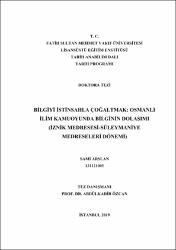| dc.contributor.advisor | Özcan, Abdülkadir | |
| dc.contributor.author | Arslan, Sami | |
| dc.date.accessioned | 2019-08-02T08:40:23Z | |
| dc.date.available | 2019-08-02T08:40:23Z | |
| dc.date.issued | 2019 | |
| dc.identifier.citation | ARSLAN, Sami, Bilgiyi İstinsahla Çoğaltmak : Osmanlı İlim Kamuoyunda Bilginin Dolaşımı (İznik Medresesi-Süleymaniye Medreseleri Dönemi), Fatih Sultan Mehmet Vakıf Üniversitesi Lisansüstü Eğitim Enstitüsü Tarih Anabilim Dalı, Yayımlanmamış Doktora Tezi, 2019. | en_US |
| dc.identifier.uri | https://hdl.handle.net/11352/2917 | |
| dc.description.abstract | Yazma eser kültürü alanında kaleme alınan bu çalışmada İznik Medresesi-
Süleymaniye Medreseleri arasındaki dönemde Osmanlı coğrafyasında istinsah
edilmiş nüshaların istinsah kayıtları ele alınmıştır. Çalışmada öncelikle nüshanın
kitaptan farkı üzerinde durulmuş, nüshanın müellif, müstensih ve okur üçgeninde
vücut bulduğu tezi ileri sürülerek bu tez tartışılmıştır. Keza ilgili dönemin
müstensihlerinin hangi motivasyonla istinsah ameliyesiyle meşgul olunduğu üzerinde
durulmuş, akabinde müstensihlerin metin üzerindeki tasarruflarından yola çıkılarak
istinsah kaydı ile telifin yapısal benzerliklerine örnekler verilmiştir.
Nüshayı nüsha yapan kayıtların başında gelen istinsah kayıtlarını oluşturan
ögelerin neler olduğu tespit edilmiştir. Buna göre istinsah kayıtlarının kendi içinde
bir düzeni ve yapısı olduğuna vurgu yapılarak bu yapıyı oluşturan ögeler tüm
veçheleriyle konu edinilmiştir.
İstinsah kayıtlarının sadece künye bilgisini veren yerler olmadığı bilakis
müstensihlerin bu kayıtlarda kendi iletişim ağları dahil birçok şeyi aslında okurun
dikkatine sunduğu tespitinde bulunulmuş ve bu çerçevede on beşinci yüzyıl Osmanlı
İstanbul’unun tartışmalı ve popüler müderrisi maktul Molla Lutfi’nin eserleri
üzerinden istinsah kayıtlarının tarih yazımına katkısı gösterilmeye çalışılmıştır. Bu
bağlamda Molla Lutfi’nin müstensihlerinin zındıklık ithamıyla idam edilen Molla
Lutfi’ye tutumuna göre istinsah kayıtlarını düzenledikleri ve temelde bu tutumlarının
neticesinde istinsah kayıtlarında sansür ya da oto sansür uyguladıkları görülmüştür. | en_US |
| dc.description.abstract | This work concerns to the field of manuscript cultures, and is devoted to the
colophones of manuscripts copies prepared in the Ottoman realms in the periods of
Iznik and Sulaymāniya madrasa traditions. At first, the difference between the actual
works and its copies is subjected. In this context the thesis put forward and
elaborated is that the copy work is a result of a triangular relation between author,
copyist and reader. A further point is the question of the nature of motivation which
induced a given copyist to engage with his particular task. Starting from the point of
the copyists modifications, a number of copies is discussed with reference to the
structual similarities between the colophones and the composition of the respective
copy. In a next step, the general patterns of copyists records as primary elements of
which a copy is constituted are identified. In this context particular attention is paid
to the fact that each of these elements feature certain characteristics, and that their
composition together follows a specific internal structure. Accordingly, these
characteristics and structures are subject of an in-depth discussion.
Beyond that it is clarified that these records provide not only basic
information on the person of the copyist as his name, his familial background or
place of origin and so forth, but that they were utilized as an opportunity to present
the reader more particular insights into a number of personal features as for example
on the personal networks. With this in mind, the impact of copyists records to
historiography are discussed. This appears on the basis of the copyists records to the
works of the executed scholar Molla Lutfi, who was a figure as popular as
controversal of 15th century Istanbul. Within this context it has been shown that the
copyists of the works of Molla Lutfi, who has been sentenced to death on the ground
of the charge of heresy, shaped their records according to their own approach to the
figure of Molla Lutfi and this accusation, and, in doing so, practiced censorship or
self-censorship depending on their attitude, respectively. | en_US |
| dc.language.iso | tur | en_US |
| dc.publisher | Fatih Sultan Mehmet Vakıf Üniversitesi, Lisansüstü Eğitim Enstitüsü | en_US |
| dc.rights | info:eu-repo/semantics/openAccess | en_US |
| dc.title | Bilgiyi İstinsahla Çoğaltmak : Osmanlı İlim Kamuoyunda Bilginin Dolaşımı (İznik Medresesi-Süleymaniye Medreseleri Dönemi) | en_US |
| dc.type | doctoralThesis | en_US |
| dc.contributor.department | FSM Vakıf Üniversitesi | en_US |
| dc.relation.publicationcategory | Tez | en_US |
| dc.contributor.institutionauthor | Arslan, Sami | |



















